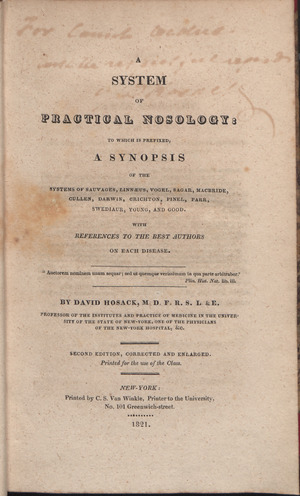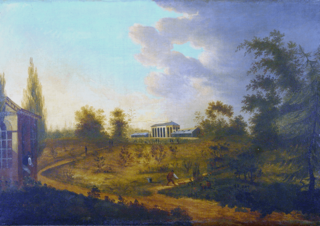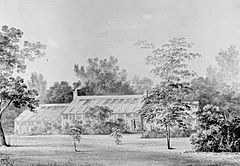David Hosack facts for kids
Quick facts for kids
David Hosack
|
|
|---|---|
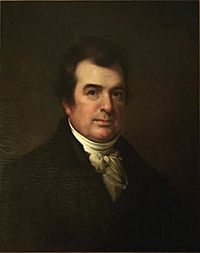
Portrait of Hosack by Rembrandt Peale, 1826
|
|
| Born | August 31, 1769 |
| Died | December 22, 1835 (aged 66) New York City, New York, U.S.
|
| Resting place |
|
| Nationality | American |
| Education |
|
| Occupation |
|
| Spouse(s) |
|
| Medical career | |
| Institutions | |
| Signature | |
David Hosack FRS FRSE FLS (August 31, 1769 – December 22, 1835) was an important American doctor, plant expert, and teacher. He is famous for being the doctor who helped Alexander Hamilton after his duel with Aaron Burr in 1804. Sadly, Hamilton was badly hurt and died. Hosack had also helped Hamilton's son, Philip, after a similar duel a few years earlier.
David Hosack started many important places. These include the Elgin Botanic Garden and a medical school at Rutgers University. He worked hard to improve medical education and care in the early United States.
Contents
David Hosack's Early Life and College Years
David Hosack was born in New York City. He was the first of seven children. His father, Alexander, was a merchant from Scotland. After the American Revolutionary War, David went to schools in New Jersey.
He then attended Columbia College, which is now part of Columbia University. He first studied art, but soon became very interested in medicine.
At Columbia, Hosack learned from Dr. Richard Bayley. In 1788, while he was studying at New York Hospital, a big protest happened. People were angry about doctors using bodies from graveyards for medical training. This event was called the 1788 doctors' riot. David Hosack was even hurt trying to protect the hospital's lab.
After this, Hosack left Columbia. He moved to Princeton University (then called the College of New Jersey). He earned his Bachelor of Arts degree from Princeton in 1789.
Becoming a Doctor and Starting Practice
In 1789, after graduating from Princeton, Hosack continued his medical studies. He learned from Dr. Nicholas Romayne. He often visited homes for the poor and sick to get real-world medical experience.
In 1790, Hosack moved to medical school in Philadelphia. He wrote his final paper on cholera, a serious illness. He got married in early 1791. That spring, he earned his medical degree from the University of Pennsylvania.
In 1791, Hosack and his wife, Catharine, moved to Virginia. There, he opened his first medical office. They returned to New York City a year later.
Hosack believed that the best doctors had studied in Europe. He convinced his father to pay for him to go to Britain. He studied at the University of Edinburgh in Scotland. There, he realized he needed to learn more about plants. He spent a lot of time in botanical gardens and became a leading expert in botany.
Hosack came back to America in 1796. He started a medical practice in New York City. He became known as a family doctor, helping with children's health and childbirth. He also gained a reputation for living a good life and being a dedicated family man.
The Hamilton–Burr Duel and Dr. Hosack
David Hosack was the family doctor for Alexander Hamilton. He is most known for being present at the famous duel between Hamilton and Aaron Burr. This duel happened in Weehawken, New Jersey, on July 11, 1804.
Hosack was a friend to both Hamilton and Burr. After Burr fired, Hosack treated Hamilton's serious injuries. He went with Hamilton across the river to a nearby home, where Hamilton died the next day. Hosack had also treated Hamilton's son, Philip, after he was fatally shot in a duel in the same spot in 1801. Hosack was one of the people who carried Hamilton's coffin at his funeral.
Years later, Hosack even helped Aaron Burr. He loaned Burr money to travel to Europe. Burr lived there for several years.
Hosack's Contributions to Medicine and Science

In 1801, Hosack created America's first botanical garden. He called it the Elgin Botanic Garden. He named it after his father's hometown in Scotland. He designed it like the gardens he had seen in Europe.
Teaching and Medical Education
One of Hosack's most famous students was Dr. John Franklin Gray. Gray later became the first doctor in the U.S. to practice homeopathy. This was a different kind of medicine. Because Gray chose homeopathy, Hosack ended their friendship.
Starting Hospitals and Schools
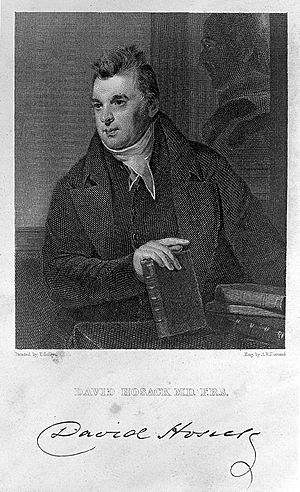
New York's First Maternity Hospital
In 1798, after a yellow fever outbreak, Hosack wanted to open a special hospital. It would be a maternity clinic for poor pregnant women. He raised money from people like Alexander Hamilton. The Lying-In Hospital opened in 1799. It helped many women and children.
The hospital moved in 1801. It closed in 1827 when its rented space was no longer available. However, the idea lived on. It later became part of what is now NewYork–Presbyterian Hospital.
Creating Medical Colleges
Hosack believed that medical education should be easy to get. He and his former teacher, Dr. Nicholas Romayne, worked to start new medical schools.
One of Hosack's successes was joining the College of Physicians and Surgeons with Columbia University. He also worked with Rutgers College in New Jersey. Medical classes began at Rutgers in 1826. But some doctors in New York did not like this.
Hosack faced challenges from other medical groups. They said he was interfering with medical education laws.
After this setback, Hosack found support from Geneva College in New York. The medical school from Rutgers then moved its loyalty to Geneva. But a court later ruled that the college could not have a branch in New York City.
Horticulture and Plant Science
In 1801, Hosack created the Elgin Botanic Garden. He bought twenty acres of land outside New York City for it. This land is now where Rockefeller Center stands.
Hosack wanted the garden to collect and grow native plants. He was especially interested in plants used for medicine. He spent a lot of his own money on the garden. By 1805, it had 1,500 types of plants from all over the world. Even Thomas Jefferson sent some rare plants.
Hosack could not afford to keep the garden going forever. The State of New York bought Elgin from him in 1810. The state then gave it to Columbia College. Columbia did not want to pay for the garden. The Elgin Botanic Garden was eventually left to decay. Later, the land was leased for the building of Rockefeller Center.
David Hosack's Personal Life
Family and Life Events

In 1791, David Hosack married Catharine Warner. Their son, Alexander, was born in 1792. Sadly, his son died after Hosack returned from Scotland. His wife, Catharine, also died in 1796 while giving birth to their second child, who also passed away.
These sad events, along with serious yellow fever outbreaks, made Hosack want to improve medicine. He focused on training doctors to care for women and children. He also became a founder of the Humane Society, helping the poor.
About two years after his first wife died, Hosack married Mary Eddy. They had nine children, and seven lived to be adults. One of their sons, Alexander Eddy Hosack, became a surgeon like his father.
Social and Learning Activities
Hosack helped start the New-York Historical Society. He was also its fourth president. He was a member of many important groups. These included the American Philosophical Society and the American Academy of Arts and Sciences. He was also elected to the Royal Swedish Academy of Sciences.
His Final Days
A huge fire, called the Great Fire of New York, started in December 1835. It destroyed many buildings in New York City. Hosack lost a lot of his own property in this fire.
He died of a stroke one week later, on December 22, 1835. He was first buried at New York Marble Cemetery. In 1888, his family moved his grave to Trinity Church Cemetery. This is the same cemetery where Alexander Hamilton is buried.
Selected Works by David Hosack
- An introductory lecture on medical education (1801)
- Observations on the Canada thistle (1810)
- Observations on the establishment of the College of Physicians and Surgeons in the city of New-York (1811)
- Observations on the surgery of the ancients: vindicating their claims to many of the reputed discoveries and improvements of modern times (1813)
- Observations on the advantages of exposing wounds to the air after capital operations (1813)
- Observations on vision (1813)
- Observations on the laws governing the communication of contagious diseases: and the means of arresting their progress (1815)
- Tribute to the memory of the late Caspar Wistar (1818)
- System of practical nosology (1821)


